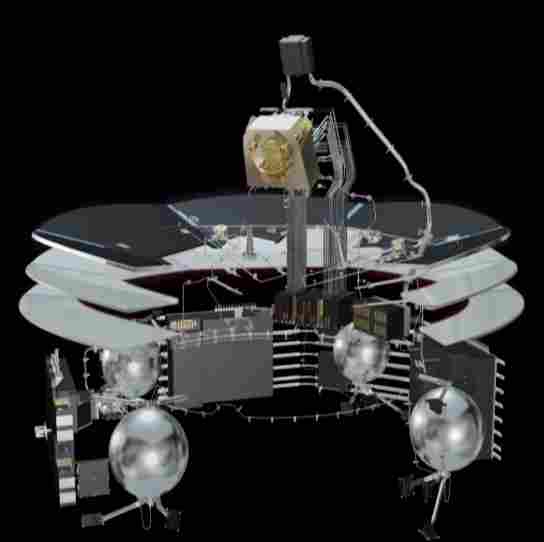
The two instruments on Planck have to be cooled to low temperatures in order to reduce the inherent noise that would drown out the tiny signals that are being measured. This is achieved by a series of cooling stages, known as the cryogenic system. The image on the right shows the cooling systems connected to the satellite with all the other parts of the satellite removed.
The whole telescope and both instruments are first cooled to 50 K (-223oC) by taking advantage of the cold temperatures of deep space by radiative cooling. This is achieved by the three large “petals” that can be seen in the picture. These have a large surface area that maximizes the cooling power. The Low Frequency Instrument (LFI) is then cooled to 20 K (-253oC) by a “sorption cooler”. This works by using materials (metal hydrides) that absorb hydrogen at low temperature and evolve it at high temperature. This material is used in beds that are sequenced so that when one bed is absorbing another is being heated to give out hydrogen. In this way, the high pressure gas is pre-cooled to the temperature of the radiative cooler then expanded through a narrow orifice (a process called Joule-Kelvin expansion). Under these conditions the hydrogen cools to around 20 K. The use of the metal hydride beds to provide compression of the gas means that there are no moving parts. The cooler therefore has inherently low vibration that could upset the measurements.
The cooling of the High Frequency Instrument (HFI) requires a further two levels of cooling on top of the sorption cooler used for LFI. The first is another Joule-Kelvin cooler which uses Helium as the working gas to reach temperatures around 4 K. This has balanced mechanical compressors to achieve the compression and is pre-cooled by both the radiative and hydrogen sorption cooler. The second stage which reaches 0.1 K is a “Dilution refrigerator”. This mixes 3He and 4He (two isotopes of helium, having the same number of protons but a different number of neutrons) and uses their different quantum-mechanical properties to reduce the temperature. The 3He is dissolved into the 4He creating a cooling effect. The helium is stored in the four globes shown above, and vented into space after use. This finite supply of helium is what limits the lifetime of HFI.
More information on the cooling systems can be found here and here. Click on the image above to see an animation of the Planck satellite begin built up step by step.